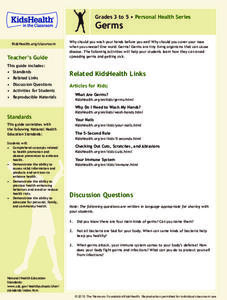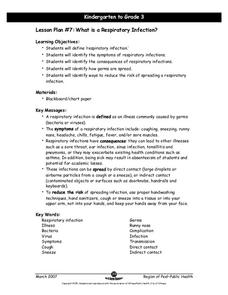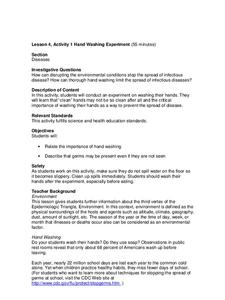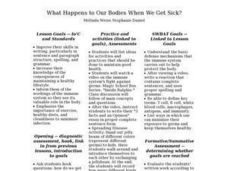Nemours KidsHealth
Germs: Grades 9-12
Beware the bugs! Two activities engage high schoolers in the study of germs, what they are, what they do to the body, and what can be done to prevent them from spreading. After reading a series of related articles, groups create a...
Curated OER
HIV/AIDS & Other STDs, Day 1: Germs & Risk
Assist your secondary special education class for understanding risky behavior, hygiene, and STDs. The class discusses how germs spread, how people get sick, and what needs to be done to prevent the spread of communicable diseases. They...
Nemours KidsHealth
Germs: Grades 3-5
Infection prevention is the focus of two lessons. In lesson one, scholars take a brief quiz, survey peers, and discuss prevention techniques to stay healthy. Lesson two examines how germs work—transmission, symptoms, treatments, and...
Nemours KidsHealth
Germs: Grades 6-8
As part of their study of bacteria, viruses, fungi, and protozoa, middle schoolers create engaging public service announcements for preschool and kindergarten classes, teaching them how and when to wash their hands. To begin, class...
Curated OER
Washing Germs Away
Students investigate germs. For this cross curriculum health and biology lesson, students listen to Old Black Fly by Jim Aylesworth and identify ways in which flies spread germs. Students discuss hand washing during a visit by the school...
King Country
Lesson 24: HIV/AIDS & Other STDs - Day 1: Germs & Risk
This first lesson on sexually transmitted diseases focuses on germs, what they are, how they travel, and methods of protecting oneself from germs.
Curated OER
Making Germ Monsters
Students explore germs. For this literacy and health lesson, students listen to the book Germs! Germs! Germs! by Bobbi Katz and discuss methods that prevent the spreading of germs. Students cut symmetrical shapes out of construction...
Nemours KidsHealth
Germs: Grades K-2
Students demonstrate knowledge about germs. In this health activity, students investigate what germs are, how to protect the skin by comparing the skin to apple skins, and the proper hand washing technique for getting rid of germs....
Curated OER
Potato Experiment
Spur a discussion of germs using this lesson. Learners conduct an experiment with potatoes to determine how germs are transmitted. They then discuss ways to prevent the spread of germs. The emphasis is on hand washing.
Curated OER
Antibiotic Attack
Students examine how antibiotics work and why they are effective. In this antibiotic lesson, students discover that when harmful germs get inside the body, the immune system may not be strong enough to fight the germs off. Students...
Peel-Public Health
What Is Respiratory Infection?
Give your youngsters a comprehensive introduction to the importance of washing hands and preventing the spread of germs in three activities, which include identifying what germs are, discovering where germs live, and practicing a...
Children’s Hospital of Philadelphia
Meet the Germs
A lesson introduces scholars to the scientist, Martinus Beijerinck, the person behind virus discovery. Learners research and complete a graphic organizer that showcases the differences between a virus and bacteria. Small groups share...
Curated OER
How Germs Spread
Fourth graders investigate how germs spread in this lesson. They listen to "The Flea's Sneeze" by Lynn Downey and make predictions on why the hog began sneezing. They then conduct an experiment using flour and paper cups demonstrating...
Curated OER
The Case of the Classroom Cleanup
Learners complete activities to learn about germs in their classroom and healthy habits. In this germs and health lesson, students participate in a classroom cleanup activity. Learners draw germs on a poster of the classroom and identify...
Nemours KidsHealth
Cold and Flu: Grades 6-8
Wouldn't it be lovely if people were immune from colds and flu? Alas, such is not the case; however, there are things we can do to avoid getting or spreading these pesky health hazards. Middle schoolers read articles that provide them...
Centers for Disease Control and Prevention
Hand Washing Experiment
An engaging experiment allows scholars to understand why the recommendation is to wash for 20 seconds with soap and water — while making them aware of their own habits!
Children’s Hospital of Philadelphia
Meet the Heros
Vaccine development is the focus of a lesson that explores its history, timeline, and how the scientific method aids the process. Following a discussion about Edward Jenner and Small Pox, learners answer questions in their journals then...
Curated OER
What Happens to Our Bodies When We Get Sick?
Seventh graders explore ways in which they become sick. They find out ways that there bodies fight off bacteria. Students watch a video from the Magic School Bus series:"Inside Raphie." After reviewing video students can openly discuss...
food.uk.gov
Kitchen Check
Storing the food in the fridge, keeping the kitchen clean, and preparing food correctly are the focus topics of this food safety resource. It includes well-designed handouts with top tips to remember, coloring worksheets, and answer keys.
Curated OER
Why Does My Body Smell?
Fourth graders investigate how germs spread among people. In this health activity, 4th graders discover the causes of infection and proper hygiene methods.
Curated OER
4th Grade Food Safety Lesson
From a high-speed hand-washing lesson to identifying important nutrients in fruits and veggies, this resource has several activity ideas and worksheets for teaching food safety to your learners.
Curated OER
The Human Body
Explore the human body through hands-on activities. Young learners will trace their bodies and place cut out body organs in the proper place, print patterns using cut fruit, sing songs about good nutrition, and use their five senses...
Curated OER
4-H Nutrition, Health & Fitness: Hand Washing
Healthy habits are a must. This 4-H resource delves into the importance of proper hand washing. This could lead to a discussion of other ways to keep healthy.
Curated OER
Dietary Rules
Healthy eating habits is the focus of this resource. Learners discuss fat and cholesterol, caloric needs, and the importance of exercise. There is a worksheet and a handout of dietary guidelines to supplement the information provided.

























